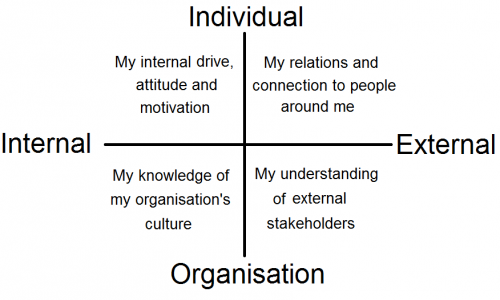
Learning and development is a key component in our overall wellbeing.
In order for you to learn – there needs to be a gap: A gap between your desired results/performance and your current ability. This was the topic of last week’s post where you can find a more detailed explanation.
You may of course not be getting the results you hoped for despite the fact that you have the ability. I.e. you know what to do but you are not doing it. That is not a learning challenge but a motivational challenge – the cure for that could be a bit of coaching but that is topic for another day.
We can look at our roles from two perspectives. There is a management perspective and a leadership perspective. Identifying the gap from a management perspective is often quite easy. In our roles as managers, there are typically some quite explicit expectations that have measurable metrics attached to them.
But the other part of our job – the leadership aspect does not come with the same set of quantifiable metrics. So how can we identify the gaps here?
One way of doing it is to use the DAC framework developed by Center for Creative Leadership. I wrote about that in a previous post that you will find here.
So to what extent do you feel that there is direction, alignment and commitment on the team that you are leading?
Take look at the matrix below and ask you self that hard questions on each of these. Where is my team and where would I like them to be?
| Happening | Not Happening | |
| Direction | – There is a clear vision of a desired future that everyone buys into. – Team members are individually clear on what the team is trying to achieve as a whole. |
– No agreement on priorities – Team members feel they are bingo pulled in multiple directions. – There is lots of activity but not much progress. |
| Alignment | – Roles and goals are clear individually. – There is a clear understanding of how each and everyone contributes to the larger picture. – There is a sense that this is a well coordinated and synchronised effort. |
– Deadlines are missed. Rework required and lots of errors resulting in double work. – People feel disconnected from each other. – Internal competition and blame games are the norm. |
| Commitment | – Team members go the extra mile. – There is a sense of mutual understating and trust. – There are visibly high levels of engagement. |
– Only the easy things get done. – Team members are questioning what is in it for them. – Individuals avoid taking ownership and responsibility. |
Is there a gap?
So back to the learning – for learning to happen you must declare your incompetence. “I would like to achieve xyz but actually I don’t quite know how to get there.”
How does that feel? Scary, intriguing, motivating? Whatever you are feeling, what is important is that you are slightly out of your comfort zone – because that is where learning, growth and development actually take place. So if it feels a bit uncomfortable – great, you are on track.
There is a great learning opportunity.
______________________________________________________________
If you have the curiosity to take a deeper dive into the subject of how we produce engagement on our teams, you are welcome to download my ebook Understanding Engagement.
Enter your email below and download the ebook now!
In this brief e-book, we will look at how the lack of engagement is to a large extent a function of leadership. And that if we really want to change the engagement levels on our teams, we will need to make radical shift in how we understand the world of work. The shift is all about moving from a transactional mindset to a transformational mindset. We will look into what that means, how it can help you as a manager and why it is so important.











